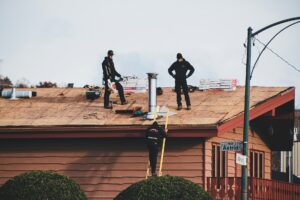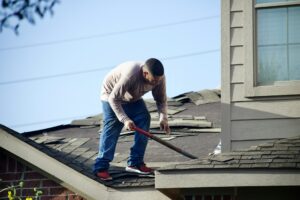Homeowners in Bend, Oregon, have felt the squeeze of soaring construction materials prices, and roofs have become a particularly heavy investment. The high desert climate near the Cascades demands resilient roofing solutions that stand up to blistering sun and snowy winters. By carefully considering factors such as material choices, warranty coverage, and professional labor expenses, it’s possible to stay ahead of budget surprises while securing a protective, long-lasting roof.
This guide explores strategies for effectively budgeting a roof replacement under 2025’s challenging market conditions. Whether replacing a worn-out roof or planning, you’ll find practical tips for cost-conscious decision-making and local insights that turn uncertainty into clarity.
Why Roof Replacement Costs Are Rising
Many Bend homeowners are experiencing sticker shock when getting quotes for roof replacements. A big part of these rising costs comes from global supply-chain disruptions. During the past few years, construction material manufacturers have struggled with raw material setbacks, labor shortages, and shipping congestion. A supply-and-demand imbalance results: fewer materials are circulating, and prices are markedly higher.
Another key factor is the unique environment in Central Oregon, which can speed up roof wear. Extreme temperature swings—intense summer heat and freezing winter nights—put roofing materials under stress. This can reduce overall lifespan, increasing local demand for roof replacements. With homeowners lining up for new shingles, installation costs have risen due to high labor demand.
Understanding the Bend Roofing Landscape
A few distinct local factors shape roofing in Bend. First, standing up to the volatile climate requires higher-grade materials built to tolerate repeated freeze-thaw cycles. Second, roof replacements often require specific permits and inspections through the City of Bend Building Services, which ensures compliance but can add to the timeline and fees.
Here are a few Bend-specific factors that affect costs:
- Home architecture: Many houses in Bend incorporate modern mountain or craftsman-inspired designs with multiple roof planes and steep pitches. This adds complexity and labor time.
- Regional building codes: Roofs must sometimes meet seismic or wildfire safety standards, requiring additional materials and specialized installation methods.
- Skilled trade shortages: The city’s growth fuels demand for trained roofers, driving labor rates and wait times.
All these elements can contribute to your final replacement bill. By pinpointing these added costs early, you’ll have fewer surprises.
Setting Realistic Budgets
Setting a realistic budget is crucial for roof replacement projects. While it’s tempting to aim for the lowest quote, low bids can hide potential pitfalls, such as lower-grade materials or rushed labor. The cost to redo a subpar roofing job can be far greater in the long run.
A helpful rule of thumb is to gather at least three estimates from licensed local roofing contractors. As you compare them, confirm that the scope of work is consistent across each bid. Look for these key details:
- Exact roofing material type, brand, and quality grade.
- Estimated lifespan specified by the manufacturer (e.g., 20-year shingles, 30-year shingles).
- Underlayment specifications, including waterproofing membranes if needed.
- Ventilation additions or improvements.
- Warranty details, including artistry and manufacturer guarantees.
- Permitting fees and other incidental costs.
You can spot any significant discrepancies by reviewing multiple quotes in such detail and zeroing in on the best value.
Exploring Material Options
In Bend, material choice can mean the difference between a roof that barely passes building inspections and one that comfortably withstands relentless climate conditions. With 2025’s rising costs, choosing the right material can save money in the long term by reducing future maintenance.
Standard roofing options in the region include:
Asphalt Shingles:
Pros: Budget-friendly, widely available, modern styles often come with decent lifespans.
Cons: May need earlier replacement in Bend’s intense freeze-thaw cycle.
Metal Roofing:
Pros: Exceptional durability, reflects heat well, relatively lightweight, and often qualifies for insurance discounts in fire-prone areas.
Cons: More expensive and may require specialized installers.
Composite or Synthetic Shingles:
Pros: It mimics the appearance of slate or wood shakes, is lighter than real tile or stone, and is more durable than low-grade asphalt.
Cons: Higher upfront cost, but a longer lifespan can balance out long-term costs.
Cedar Shakes:
Pros: A classic look blends beautifully with Bend’s natural surroundings.
Cons: The cons are that it is Susceptible to mold and moss if not cared for carefully, and local fire codes may require added treatments.
Weigh the initial investment against the expected lifespan. Some pricier materials offer decades of service with fewer repairs, so that the premium can pay off in fewer replacements over the lifetime of your home.
Timing Potential Cost Fluctuations
One of the most innovative ways to adapt to rising building costs is to time your project well. Roof replacements in early spring or late fall sometimes come with less labor competition, though be mindful of seasonal weather disruptions. You’ll want to avoid mid-winter tear-offs if persistent snowfall is likely.
Additionally, watch for construction industry news. If forecasts predict continued material shortages, consider scheduling earlier than planned. Locking in a contract before peak demand can give you a better shot at stable pricing.
Creating a Contingency Fund
Even the best-planned budget can be upended by hidden issues uncovered during a roof replacement. Mold, rotting plywood, or out-of-code structural elements can add thousands of dollars to the anticipated total. Building a contingency fund—usually 10–15% of your central budget—is a practical safeguard.
This reserve covers unexpected extras without forcing you to compromise on critical repairs. If significant structural damage isn’t found, those funds remain available for enhancements like upgraded gutters or advanced ventilation systems. A cushion allows flexibility without pushing your household finances to the brink.
Exploring Financing and Incentives
Many homeowners find that financing options ease the immediate pressure of replacing a roof. Lenders in Bend often offer home improvement loans with competitive interest rates, allowing you to spread the costs over time. If you can manage a larger down payment, you could secure more favorable terms.
For eco-friendly solutions, consider Oregon’s Energy Trust rebate programs when applicable. Certain roofing materials that improve energy efficiency may qualify for incentives. Although coverage for roof replacements alone can be limited, partial rebates might be available for additional upgrades like insulation or efficient attic ventilation.
Here are some financing and incentive tips:
- Check for local credit unions or community banks offering home improvement loans with flexible terms.
- Ask roofing contractors about in-house financing or partnerships with lenders. (Some contractors negotiate lower interest rates for their clients.)
- Inquire with insurance providers if installing a specific roof type qualifies you for coverage discounts. Metal roofs, for instance, often come with reduced hazard risk.
Negotiating Warranties
A roof replacement is never just about the shingles; it’s an investment in long-term structural protection. That’s why it’s essential to weigh the cost of materials and the caliber of warranties. Many roofing products come with manufacturer warranties that span 20 years or more, but details can vary.
Additionally, professional installers often offer artistry warranties. Look for:
- Transferable warranties, which can increase your home’s resale value if you choose to sell.
Coverage for a broad range of potential defects, not just surface-level issues.
Clear terms on artistry coverage—verify whether labor or materials get priority if a defect emerges.
Strong warranties can offset a higher purchase price, ensuring that if unexpected problems arise, you won’t have to bear the entire financial burden.
Collaborating with Local Experts
Given Central Oregon’s unique environment, local roofers have valuable knowledge of climate conditions and building permits. They can recommend materials best suited to Bend’s freeze-thaw cycles, and they typically know how to streamline inspections. When interviewing roofing companies, ask about:
- Experience with local roofing codes and typical city inspection processes.
- Knowledge of snow load requirements and how they affect roofing underlayment.
- Familiarity with everyday issues like ice dams requires proper ventilation and insulation.
Seasoned roofers can also anticipate the hidden costs that many newcomers overlook. This insight often pays for itself, preventing budget overruns and guaranteeing a smoother installation process.
Coordinating Inspections and Permits
Before any tear-off begins, confirm your roofing contractor has handled the necessary permits. Overlooking or delaying this can mean costly surprises or project delays. In Bend, standard procedures often involve:
- Submitting a roofing permit application, describing materials, and estimated costs.
- Scheduling inspections at key installation points.
- A final review once the job is completed.
Budgeting extra time to schedule those inspections is wise, especially during peak construction seasons. Having all documentation in order minimizes the risk of removing and reinstalling roof sections to correct code violations.
Proactive Maintenance for Cost Savings
A comprehensive maintenance plan can extend the life of your new roof and help you steer clear of unexpected repair bills. Incorporating simple habits can significantly reduce stress on your budget:
- Clear debris: Remove leaves, branches, and pine needles from gutters and roof valleys. Excess debris can trap moisture, increasing wear.
- Check attic insulation: Aim for a well-insulated attic that regulates temperature and prevents ice dams. Proper insulation also often reduces heating and cooling bills.
Schedule regular inspections: A professional checkup every few years can spot minor issues, like popped nails or worn flashing, before they become major leaks. - Seal penetrations: Ensure vent pipes, skylights, and chimneys have properly maintained seals. Small leaks here can easily turn into significant repairs.
Routine upkeep isn’t just a chore; it’s a lifeline to a longer-lasting roof.
Looking Ahead: The Future of Bend’s Roofing Market
Bend’s housing market shows no signs of slowing, with new developments and more residents drawn by the region’s natural beauty. Demand for construction materials is projected to remain strong. This means that budgeting for a roof replacement may continue to require creativity and forward-thinking.
At the same time, greater emphasis on sustainable building might drive interest in energy-efficient roofing solutions. In the next few years, advanced solar-shingle technology may become more accessible, turning a simple roof replacement into an opportunity for energy generation. While these innovations can be costly at the outset, ongoing utility savings offset the price over time.
By planning carefully today—staying informed about financing, anticipating rising material costs, and investing in durable materials—homeowners can confidently navigate Bend’s future.
An Upward Path, One Shingle at a Time
Budgeting for your roof replacement in Bend doesn’t need to be daunting, even with 2025’s rising costs. Doing your homework on materials, permits, and local labor markets empowers you to make wise decisions, safeguarding your home and wallet. Take advantage of financing opportunities if they suit your comfort level, explore potential incentives for efficiency upgrades, and remember the value of reliable warranties.Each step of this process—from obtaining multiple roofing contractor estimates to assembling a contingency fund—helps shield you from unpleasant surprises. A new roof isn’t just a single upgrade; it’s a stable foundation protecting everything underneath it. By approaching your replacement with clarity and organization, you ensure that your investment aligns with Bend’s unique demands while keeping your budget solid.




